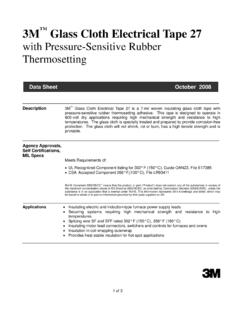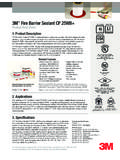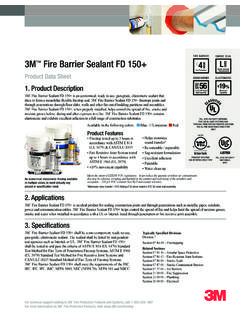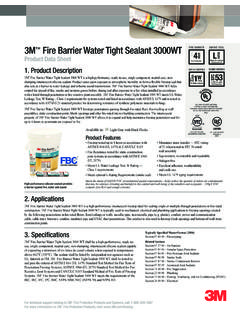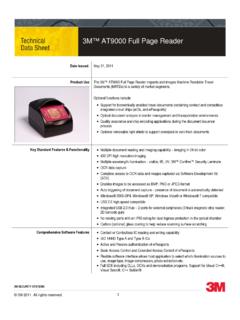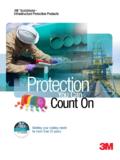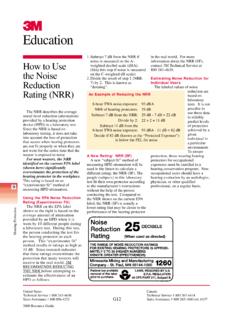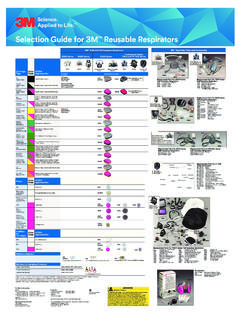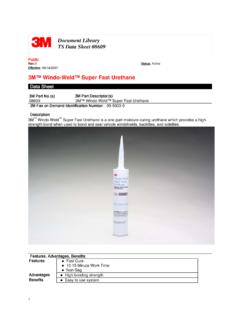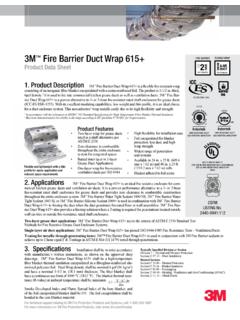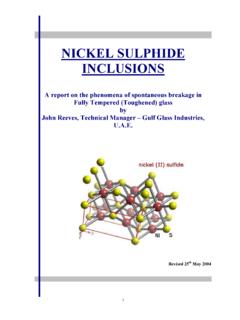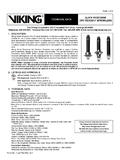Transcription of Surface Preparation and Pretreatment for …
1 Surface Preparation and Pretreatment for structural Adhesives Technical bulletin October 2018 Working directions for advanced Surface Preparation techniques to obtain optimum adhesion between materials with 3M Scotch-Weld structural Adhesives. structural adhesives depend on the interfacial relationship of the adhesive and the substrate. To optimize the performance the substrate Surface Preparation is critical. Bonds of high strength on metals, plastics, etc. can be obtained after removal of grease and loose Surface deposits, rust, from the surfaces to be joined, but when maximum strength is required, a more thorough mechanical or a chemical Pretreatment is recommended.
2 surfaces are prepared by one of the following procedures (listed in order of increasing effectiveness): 1. Degrease only. 2. Degrease, abrade, and solvent clean. 3. Degrease and chemically pre-treat. After cleaning, care must be taken to avoid contaminating the pretreated surfaces prior to bonding. Contamination may be caused by finger marking, or by cloths which are not perfectly clean, or by using sub-standard degreasing or chemical solutions. Whatever the Pretreatment procedure used, it is good practice to bond the surfaces as soon as possible after completion of the Pretreatment when Surface properties are at their best. This bulletin will offer suggestions for Surface Preparation of the most commonly bonded materials.
3 Materials less commonly used and not specifically dealt with in this manual may require only simple degreasing and abrading (as described below) but if other pretreatments appear necessary advice should be obtained from 3M. While the advice in this manual is intended to cover most situations, you should verify with testing that suggested pretreatments are effective with your specific substrates. The removal of all traces of oil and grease from the surfaces to be bonded is essential for the highest strength, most durable bonds. Degreasing by one of the three methods given below should be carried out even when the surfaces to be bonded appear clean. Degreasing Technical bulletin Surface Preparation and Pretreatment for structural Adhesives (1) Suspend in 3M Novec 72DE Engineered Fluid or 3M Novec 72DA Engineered Fluid (or equivalent vapor degreasing product), (2) Wipe the joint surfaces with a clean cloth soaked in 3M Novec Electronic Degreaser, MEK, acetone or isopropyl alcohol (IPA)* and allow to stand for a minute or two to permit complete evaporation from the joint surfaces .
4 (3) Or scrub the joint surfaces in a solution of detergent or, for metals only, immerse or spray in a suitable alkaline degreasing agent. After degreasing, wash with clean hot water and allow to dry thoroughly - preferably in a stream of hot air. Ultrasonic degreasing has been found to give excellent results when pretreating very small components with 3M Novec 72DE Engineered Fluid, 3M Novec 72DA Engineered Fluid, and detergent-based degreasing solutions. Alcohol, gasoline, and paint thinners are not effective in removing grease, or may leave a residue. To find out whether a Surface has been properly degreased, drip distilled water onto it. If the water forms a film, the Surface is free from grease. If it forms drops, the Surface will have to be degreased again.
5 Note: Not reliable on anodized light alloys as water will sometimes form a film on their surfaces even though not properly degreased. *Note: When using solvents, extinguish all ignition sources and follow the manufacturer s precautions and directions for use when handling such materials. Certain structural Adhesives, such as 3M Scotch-Weld Epoxy Adhesive DP920 and 3M Scotch-Weld Acrylic Adhesives, are designed to bond through many oils on the Surface of metals, thus allowing protective oils to remain in place and/or reducing the effort needed for Surface Preparation prior to bonding. Results will vary depending on the oil used; testing should be performed to confirm bond strength. In general, even with these adhesives, stronger bonds are usually seen if the surfaces are properly prepared as outlined in this bulletin .
6 Lightly abraded surfaces give a better profiled Surface for adhesive bonding than do highly polished surfaces . Properly abraded surfaces show no smooth, polished areas. Abrasion treatment should always be followed by a solvent cleaning to ensure the removal of loose particles. Metal surfaces are freed from Surface deposits, tarnish, rust or mill scale, by grit-blasting. If grit-blasting equipment is not available or the metal is too thin to Abrading Bonding through Oils Technical bulletin Surface Preparation and Pretreatment for structural Adhesives withstand blast treatment, clean the joint surfaces with a wire brush, emery cloth or glass-paper. (Use grade 120-220 abrasives for steel and materials resistant to scoring, but grade 300 abrasive for light alloys and less resistant materials, and very high viscosity adhesives.)
7 ScotchBrite 7447 pads can be effective in many situations. Painted surfaces May need to be stripped with a paint stripper prior to Preparation ; otherwise the strength of the joint may be limited by the comparatively low adhesion of paint to metal. Adhesives will generally adhere well to most paints; however, adhesion of paint to underlying metal may lead to lower joint strengths than desired. If so, removal of the paint is necessary. 2014 Technical bulletin Surface Preparation and Pretreatment for structural Adhesives The Surface Preparation described above, degreasing alone or degreasing followed by abrasion and further degreasing, is sufficient for most adhesive work. But to obtain maximum strength, reproducibility and resistance to deterioration, a chemical or electrolytic Pretreatment is required.
8 Care must be taken in the Preparation of the chemical solution, not only because of the materials involved, but also because incorrect proportioning may lead to bond strengths inferior to those that would have been obtained if there had been no chemical Pretreatment whatsoever. Time of application is also critical: too short an application does not sufficiently activate the surfaces , whereas overlong application builds up a layer of chemical reaction products which may interfere with adhesion. Both Surface structure and chemistry play a significant role in determining the strength and permanence of bonded structures. It is therefore advisable to bond or prime freshly primed clean surfaces as soon as possible after Surface Preparation in order to avoid contamination and/or mechanical damage.
9 Please contact your 3M sales representative for primer recommendations. Metals not specifically listed below should be prepared by degreasing, abrading (preferably grit blasting with a fine grit abrasive) and solvent clean. Aluminum Bare aluminum requires removal of all oxide for environmentally durable bonds. Etching is the best way to do this; a suggested etchant procedure is as follows. Optimized FPL Etch Procedure: Degreasing using an Oakite 164 solution (9-11 water) at 190 F 10 F (88 C 5 C) for 10-20 minutes. Rinse immediately in large quantities of cold running water. Material Amount Distilled Water 700 mL plus balance of liter (see below) Sodium Dichromate 28 to grams Concentrated Sulfuric Acid to grams Aluminum Chips g/L of solution Chemical Pre-treatment Metals Technical bulletin Surface Preparation and Pretreatment for structural Adhesives To prepare 1 liter of this solution, dissolve sodium dichromate in 700 ml of distilled water.
10 Add sulfuric acid and mix well. Add additional distilled water to fill to 1 liter. Heat mixed solution to 66 to 71 C (150 to 160 F). Dissolve grams of 2024 bare aluminum chips per liter of mixed solution. Gentle agitation will help aluminum dissolve in about 24 hours. To FPL etch panels; place them in the above solution at 150 to 160 F (66 to 71 C) for 12 to 15 minutes. Rinse immediately in large quantities of clear running tap water. Dry air dry approximately 15 minutes followed by force dry at 140 F (60 C) maximum for 10 minutes (minimum). Anodized Aluminum: Degrease thoroughly. Adhesion will depend on the thickness and structure of the oxide layer as well as on the type of pore sealer used. For bonds of maximum strength, it may often be necessary to abrade or etch the surfaces to be bonded.
